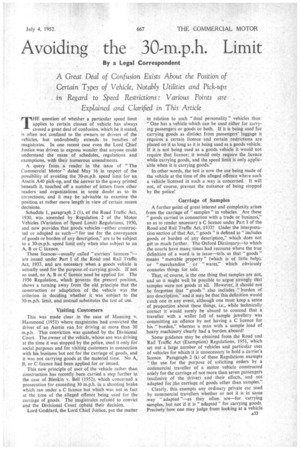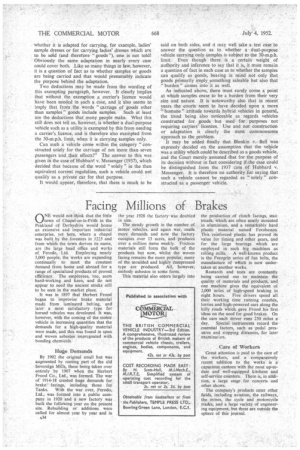Avoiding the 30-m.p.h. Limit
Page 55

Page 56

If you've noticed an error in this article please click here to report it so we can fix it.
By a Legal Correspondent A Great Deal of Confusion Exists About the Position of Certain Types of Vehicle, Notably Utilities and Pick-ups . in Regard to Speed Restrictions : Various Points are Explained and Clarified in This Article .
THE question of whether a particular speed limit applies to certain classes of vehicle, has always caused a great deal of confusion, which be it stated, is often not confined to the owners or drivers of the vehicles, but undoubtedly extends to benches of magistrates. In one recent case even the Lord Chief Justice was driven to express wonder that anyone could understand the maze of schedules, regulations and exemptions, with their numerous amendments.
A query from a reader in 'the issue of "The Commercial Motor" dated May 16 in respect of the• possibility of avoiding the 30-m.p.h. speed limit for an Austin A40 pick-up, and the answer to the query printed beneath it, touched off a number of letters from other readers and organizations in some doubt as to its correctness, and it may be advisable to examine the position at rather more length in view of certain recent decisions.
Schedule 1, paragraph 2 (1), of the Road Traffic Act, 1930, was amended by Regulation 2 of the Motor Vehicles (Variation of Speed Limit) Regulations, 1950, and now provides that goods vehicles—either constructed or adapted as such—" for use for the conveyance of goods or burden of any description," are to be subject to a 30-m.p.h. speed limit only when also subject to an A, B or C licence.
These licences—usually called "carriers' licences "are issued under Part I of the Road and Rail Traffic Act, 1933, and are necessary when a goods vehicle is actually used for the purpose of carrying goods. If not so used, no A, B or C licence need be applied for. The 1950 Regulation, which governs the present position, shows a turning away from the old principle that the construction or adaptation of the vehicle was the criterion in deciding whether it was subject to the 30-m.p.h. limit, and instead substitutes the test of use.
Visiting Customers This Was made clear in the case of Manning v. Hammond (1951) where magistrates had convicted the driver of an Austin van for driving at more than 30 m.p.h. This conviction was quashed by the Divisional Court. The owner of the vehicle, whose son was driving at the time it was stopped by the police, used it only for social purposes and for visiting customers in connection with his business but not for the carriage of goods, and it was not carrying goods at the material time. No A,
B, or C licence had been applied for or issued.
This new principle of user of the vehicle rather than construction has recently been carried a step further in the case of Blenkin v. Bell (1952), which concerned a prosecution for exceeding 30 m.p.h. in a shooting brake which ran under a C licence but which was not in fact at the time of the alleged offence being used for the carriage of goods. The magistrates refused to convict and the Divisional Court upheld their decision.
Lord Goddard, the Lord Chief Justice, put the matter in relation to such "dual personality" vehicles thus: "One has a vehicle which can be used either for carrying passengers or goods or both. If it is being used for carrying goods as distinct from passengers' luggage it requires a certain licence and certain restrictions are placed on it as long as it is being used as a goods vehicle. If it is not being used as a goods vehicle it would not require that licence; it would only require the licence while carrying goods, and the speed limit is only applicable when it is carrying goods."
In other words, the test is now the use being made of the vehicle at the time of the alleged offence where such a vehicle licensed in such a .way is concerned. It will not, of course, prevent the nuisance of being stopped by the police!
Carriage of Samples
A further point of great interest and complexity arises from the carriage of "samples "in vehicles. Are these "goods carried in connection with a trade or business," so as to render necessary a C licence under Part I of the Road and Rail Traffic Act, 1933? Under the interpretation section of that Act, " goods " is defined as "includes goods or burden of any description," which does not get us much further. The Oxford Dictionary—to which the courts, have many times had recourse where the true definition of a word is in issue—tells us that " goods " means "movable property" (which is of little help), or " merchandise " or "wares," which obviously connotes things for sale.
That, of course, is the one thing that samples are not, and so it might well be possible to argue strongly that samples were not goods at all. However, it should not be forgotten that "goods " also includes " burden of any description," and it may be that this definition would catch one in any event, although one must keep a sense of proportion about these things, i.e., while teehnically correct it would surely be absurd to contend that a traveller with a wallet full of sample jewellery was committing an offence by not ,having a C licence for his "burden,", whereas a man with a sample load of heavy machinery clearly had a burden aboard!
Some guidance may be obtained from the Road and Rail Traffic Act (Exemption) Regulations, 1951, which set out a large number of vehicles and particular uses of vehicles for which it is unnecessary to hold a carrier's licence. Paragraph 2 (k) of these Regulations exempts "the use for the purpose of soliciting orders by a commercial traveller of a motor vehicle constructed solely for the carriage of not more than seven passengers (exclusive of the driver) and their effects, and not adapted for the carriage of goods other than samples."
Clearly, this exempts any ordinary private car used by commercial travellers Whether or not it is in some -way "adapted "—as they often are—for carrying samples, but not if it is " adapted " for carrying goods. Precisely how one may judge from looking at a vehicle
whether it is adapted for carrying, for example, ladies' sample dresses or for carrying ladies' dresses which are to be sold (and therefore "goods "), one is not told! Obviously the same adaptation in nearly every case could cover both. Like so many things.in law, however, it is a question of fact as to whether samples or goods are being carried and that would presumably indicate the purpose behind the adaptation.
Two deductions may be made from the wording of this exempting paragraph, however. It clearly implies that without the exemption a carrier's licence would have been needed in such a case, and it also seems to imply that from the words "carriage of goods other than samples" goods include samples. Such at least are the deductions that many people make. What this still does not tell us, however, is whether a dual-purpose vehicle such as a utility is exempted by this from needing a carrier's licence, and is therefore also exempted from the 30-m.p.h. limit, when it is carrying samples only.
Can such a vehicle come within the category "constructed solely for the carriage of not more than seven passengers and their effects?" The answer to this was given in the case of Hubbard v. Messenger (1937), which decided that because of the word " solely " in the then equivalent current regulation, such a vehicle could not .qualify as a private car for that purpose.
It would appear, therefore, that there is much to be
said on both sides, and it may well take a test case to answer the question as to whether a dual-purpose vehicle carrying only samples is subject to the 30-mph. limit. Even though there is a certain weight of authority and inference to say that it is, it must remain a question of fact in each case as to whether the samples can qualify is goods, bearing in mind not only that goods primarily imply something saleable but also that " burden " comes into it as well.
As indicated above, there must surely come a point at which samples cease to be a burden from their very size and nature. It is noteworthy also that in recent years the courts seem to have decided upon a more " humane " attitude towards hybrid vehicles in general, the trend being also noticeable as regards vehicles constructed for goods but used for purposes not requiring carriers' licences. Use and not construction or adaptation is clearly the most commonsense approach to the problem.
It may be added finally that Blenkin v. Bell was expressly decided on the assumption that the vehicle was a utility which could be described as a goods vehicle, and the Court merely assumed that for the purpose of its decision without in fact considering if.the case could be distinguished from the 1937 case of Hubbard v. Messenger. It is therefore no authority for saying that such a vehicle cannot be regarded as " solely " constructed as a passenger vehicle.
























































































